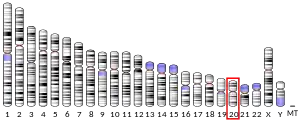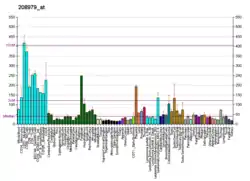Nuclear receptor coactivator 6 is a protein that in humans is encoded by the NCOA6 gene.[3][4][5]
Function
The protein encoded by this gene is a transcriptional coactivator that can interact with nuclear hormone receptors to enhance their transcriptional activator functions. The encoded protein has been shown to be involved in the hormone-dependent coactivation of several receptors, including prostanoid, retinoid, vitamin D3, thyroid hormone, and steroid receptors. The encoded protein may also act as a general coactivator since it has been shown to interact with some basal transcription factors, histone acetyltransferases, and methyltransferases.[5]
Interactions
NCOA6 has been shown to interact with:
- ASCL2[6] and
- Activating transcription factor 2,[7]
- Androgen receptor,[8]
- CREB-binding protein,[9][10]
- DNA-PKcs,[11]
- E2F1,[12]
- EP300,[11]
- Estrogen receptor alpha,[9][13]
- Estrogen receptor beta,[10][13]
- HBXIP,[14]
- HIST2H3C,[6]
- HSF1,[15]
- Ku70,[11][16]
- Ku80,[11][16]
- Liver X receptor beta,[10]
- MLL3,[6]
- RBBP5,[6]
- Retinoblastoma protein,[8]
- Retinoic acid receptor alpha,[9][10][11]
- Retinoid X receptor alpha,[9][10][13][14]
- Src,[6][9][10][17]
- TGS1,[18][19]
- TUBA4A,[6]
- TUBB,[6]
- Thyroid hormone receptor alpha,[9][17] and
- Thyroid hormone receptor beta.[9][10][11][13]
See also
References
- 1 2 3 GRCh38: Ensembl release 89: ENSG00000198646 - Ensembl, May 2017
- ↑ "Human PubMed Reference:". National Center for Biotechnology Information, U.S. National Library of Medicine.
- ↑ Nagase T, Seki N, Ishikawa K, Tanaka A, Nomura N (November 1996). "Prediction of the coding sequences of unidentified human genes. V. The coding sequences of 40 new genes (KIAA0161-KIAA0200) deduced by analysis of cDNA clones from human cell line KG-1". DNA Res. 3 (1): 17–24. doi:10.1093/dnares/3.1.17. PMID 8724849.
- ↑ Estey A, Kemp M, Allison S, Lamb C (January 1994). "Evaluation of a patient information booklet". J Nurs Staff Dev. 9 (6): 278–82. PMID 8263591.
- 1 2 "Entrez Gene: NCOA6 nuclear receptor coactivator 6".
- 1 2 3 4 5 6 7 Goo YH, Sohn YC, Kim DH, Kim SW, Kang MJ, Jung DJ, Kwak E, Barlev NA, Berger SL, Chow VT, Roeder RG, Azorsa DO, Meltzer PS, Suh PG, Song EJ, Lee KJ, Lee YC, Lee JW (January 2003). "Activating signal cointegrator 2 belongs to a novel steady-state complex that contains a subset of trithorax group proteins". Mol. Cell. Biol. 23 (1): 140–9. doi:10.1128/mcb.23.1.140-149.2003. PMC 140670. PMID 12482968.
- ↑ Hong S, Choi HM, Park MJ, Kim YH, Choi YH, Kim HH, Choi YH, Cheong J (April 2004). "Activation and interaction of ATF2 with the coactivator ASC-2 are responsive for granulocytic differentiation by retinoic acid". J. Biol. Chem. 279 (17): 16996–7003. doi:10.1074/jbc.M311752200. PMID 14734562.
- 1 2 Goo YH, Na SY, Zhang H, Xu J, Hong S, Cheong J, Lee SK, Lee JW (February 2004). "Interactions between activating signal cointegrator-2 and the tumor suppressor retinoblastoma in androgen receptor transactivation". J. Biol. Chem. 279 (8): 7131–5. doi:10.1074/jbc.M312563200. PMID 14645241.
- 1 2 3 4 5 6 7 Lee SK, Anzick SL, Choi JE, Bubendorf L, Guan XY, Jung YK, Kallioniemi OP, Kononen J, Trent JM, Azorsa D, Jhun BH, Cheong JH, Lee YC, Meltzer PS, Lee JW (November 1999). "A nuclear factor, ASC-2, as a cancer-amplified transcriptional coactivator essential for ligand-dependent transactivation by nuclear receptors in vivo". J. Biol. Chem. 274 (48): 34283–93. doi:10.1074/jbc.274.48.34283. PMID 10567404.
- 1 2 3 4 5 6 7 Lee SK, Jung SY, Kim YS, Na SY, Lee YC, Lee JW (February 2001). "Two distinct nuclear receptor-interaction domains and CREB-binding protein-dependent transactivation function of activating signal cointegrator-2". Mol. Endocrinol. 15 (2): 241–54. doi:10.1210/mend.15.2.0595. PMID 11158331.
- 1 2 3 4 5 6 Ko L, Cardona GR, Chin WW (May 2000). "Thyroid hormone receptor-binding protein, an LXXLL motif-containing protein, functions as a general coactivator". Proc. Natl. Acad. Sci. U.S.A. 97 (11): 6212–7. Bibcode:2000PNAS...97.6212K. doi:10.1073/pnas.97.11.6212. PMC 18584. PMID 10823961.
- ↑ Kong HJ, Yu HJ, Hong S, Park MJ, Choi YH, An WG, Lee JW, Cheong J (November 2003). "Interaction and functional cooperation of the cancer-amplified transcriptional coactivator activating signal cointegrator-2 and E2F-1 in cell proliferation". Mol. Cancer Res. 1 (13): 948–58. PMID 14638867.
- 1 2 3 4 Ko L, Cardona GR, Iwasaki T, Bramlett KS, Burris TP, Chin WW (January 2002). "Ser-884 adjacent to the LXXLL motif of coactivator TRBP defines selectivity for ERs and TRs". Mol. Endocrinol. 16 (1): 128–40. doi:10.1210/mend.16.1.0755. PMID 11773444.
- 1 2 Kong HJ, Park MJ, Hong S, Yu HJ, Lee YC, Choi YH, Cheong J (November 2003). "Hepatitis B virus X protein regulates transactivation activity and protein stability of the cancer-amplified transcription coactivator ASC-2". Hepatology. 38 (5): 1258–66. doi:10.1053/jhep.2003.50451. PMID 14578865. S2CID 29349615.
- ↑ Hong S, Kim SH, Heo MA, Choi YH, Park MJ, Yoo MA, Kim HD, Kang HS, Cheong J (February 2004). "Coactivator ASC-2 mediates heat shock factor 1-mediated transactivation dependent on heat shock". FEBS Lett. 559 (1–3): 165–70. doi:10.1016/S0014-5793(04)00028-6. PMID 14960326. S2CID 22383479.
- 1 2 Ko L, Chin WW (March 2003). "Nuclear receptor coactivator thyroid hormone receptor-binding protein (TRBP) interacts with and stimulates its associated DNA-dependent protein kinase". J. Biol. Chem. 278 (13): 11471–9. doi:10.1074/jbc.M209723200. PMID 12519782.
- 1 2 Lee SK, Na SY, Jung SY, Choi JE, Jhun BH, Cheong J, Meltzer PS, Lee YC, Lee JW (June 2000). "Activating protein-1, nuclear factor-kappaB, and serum response factor as novel target molecules of the cancer-amplified transcription coactivator ASC-2". Mol. Endocrinol. 14 (6): 915–25. doi:10.1210/mend.14.6.0471. PMID 10847592.
- ↑ Misra P, Qi C, Yu S, Shah SH, Cao WQ, Rao MS, Thimmapaya B, Zhu Y, Reddy JK (May 2002). "Interaction of PIMT with transcriptional coactivators CBP, p300, and PBP differential role in transcriptional regulation". J. Biol. Chem. 277 (22): 20011–9. doi:10.1074/jbc.M201739200. PMID 11912212.
- ↑ Zhu Y, Qi C, Cao WQ, Yeldandi AV, Rao MS, Reddy JK (August 2001). "Cloning and characterization of PIMT, a protein with a methyltransferase domain, which interacts with and enhances nuclear receptor coactivator PRIP function". Proc. Natl. Acad. Sci. U.S.A. 98 (18): 10380–5. Bibcode:2001PNAS...9810380Z. doi:10.1073/pnas.181347498. PMC 56969. PMID 11517327.
Further reading
- Mahajan MA, Samuels HH (July 2000). "A new family of nuclear receptor coregulators that integrate nuclear receptor signaling through CREB-binding protein". Mol. Cell. Biol. 20 (14): 5048–63. doi:10.1128/MCB.20.14.5048-5063.2000. PMC 85955. PMID 10866662.
- Nakajima D, Okazaki N, Yamakawa H, Kikuno R, Ohara O, Nagase T (2003). "Construction of expression-ready cDNA clones for KIAA genes: manual curation of 330 KIAA cDNA clones". DNA Res. 9 (3): 99–106. doi:10.1093/dnares/9.3.99. PMID 12168954.
- Carney JP, McKnight C, VanEpps S, Kelley MR (1995). "Random rapid amplification of cDNA ends (RRACE) allows for cloning of multiple novel human cDNA fragments containing (CAG)n repeats". Gene. 155 (2): 289–92. doi:10.1016/0378-1119(94)00758-K. PMID 7536696.
- Guan XY, Xu J, Anzick SL, Zhang H, Trent JM, Meltzer PS (1996). "Hybrid selection of transcribed sequences from microdissected DNA: isolation of genes within amplified region at 20q11-q13.2 in breast cancer". Cancer Res. 56 (15): 3446–50. PMID 8758910.
- Lee SK, Anzick SL, Choi JE, Bubendorf L, Guan XY, Jung YK, Kallioniemi OP, Kononen J, Trent JM, Azorsa D, Jhun BH, Cheong JH, Lee YC, Meltzer PS, Lee JW (1999). "A nuclear factor, ASC-2, as a cancer-amplified transcriptional coactivator essential for ligand-dependent transactivation by nuclear receptors in vivo". J. Biol. Chem. 274 (48): 34283–93. doi:10.1074/jbc.274.48.34283. PMID 10567404.
- Caira F, Antonson P, Pelto-Huikko M, Treuter E, Gustafsson JA (2000). "Cloning and characterization of RAP250, a novel nuclear receptor coactivator". J. Biol. Chem. 275 (8): 5308–17. doi:10.1074/jbc.275.8.5308. PMID 10681503.
- Zhu Y, Kan L, Qi C, Kanwar YS, Yeldandi AV, Rao MS, Reddy JK (2000). "Isolation and characterization of peroxisome proliferator-activated receptor (PPAR) interacting protein (PRIP) as a coactivator for PPAR". J. Biol. Chem. 275 (18): 13510–6. doi:10.1074/jbc.275.18.13510. PMID 10788465.
- Ko L, Cardona GR, Chin WW (2000). "Thyroid hormone receptor-binding protein, an LXXLL motif-containing protein, functions as a general coactivator". Proc. Natl. Acad. Sci. U.S.A. 97 (11): 6212–7. Bibcode:2000PNAS...97.6212K. doi:10.1073/pnas.97.11.6212. PMC 18584. PMID 10823961.
- Lee SK, Na SY, Jung SY, Choi JE, Jhun BH, Cheong J, Meltzer PS, Lee YC, Lee JW (2000). "Activating protein-1, nuclear factor-kappaB, and serum response factor as novel target molecules of the cancer-amplified transcription coactivator ASC-2". Mol. Endocrinol. 14 (6): 915–25. doi:10.1210/mend.14.6.0471. PMID 10847592.
- Mahajan MA, Samuels HH (2000). "A new family of nuclear receptor coregulators that integrate nuclear receptor signaling through CREB-binding protein". Mol. Cell. Biol. 20 (14): 5048–63. doi:10.1128/MCB.20.14.5048-5063.2000. PMC 85955. PMID 10866662.
- Lee SK, Jung SY, Kim YS, Na SY, Lee YC, Lee JW (2001). "Two distinct nuclear receptor-interaction domains and CREB-binding protein-dependent transactivation function of activating signal cointegrator-2". Mol. Endocrinol. 15 (2): 241–54. doi:10.1210/mend.15.2.0595. PMID 11158331.
- Hong S, Lee MY, Cheong J (2001). "Functional interaction of transcriptional coactivator ASC-2 and C/EBPalpha in granulocyte differentiation of HL-60 promyelocytic cell". Biochem. Biophys. Res. Commun. 282 (5): 1257–62. doi:10.1006/bbrc.2001.4727. PMID 11302752.
- Iwasaki T, Chin WW, Ko L (2001). "Identification and characterization of RRM-containing coactivator activator (CoAA) as TRBP-interacting protein, and its splice variant as a coactivator modulator (CoAM)". J. Biol. Chem. 276 (36): 33375–83. doi:10.1074/jbc.M101517200. PMID 11443112.
- Zhu Y, Qi C, Cao WQ, Yeldandi AV, Rao MS, Reddy JK (2001). "Cloning and characterization of PIMT, a protein with a methyltransferase domain, which interacts with and enhances nuclear receptor coactivator PRIP function". Proc. Natl. Acad. Sci. U.S.A. 98 (18): 10380–5. Bibcode:2001PNAS...9810380Z. doi:10.1073/pnas.181347498. PMC 56969. PMID 11517327.
- Jung DJ, Na SY, Na DS, Lee JW (2002). "Molecular cloning and characterization of CAPER, a novel coactivator of activating protein-1 and estrogen receptors". J. Biol. Chem. 277 (2): 1229–34. doi:10.1074/jbc.M110417200. PMID 11704680.
- Ko L, Cardona GR, Iwasaki T, Bramlett KS, Burris TP, Chin WW (2002). "Ser-884 adjacent to the LXXLL motif of coactivator TRBP defines selectivity for ERs and TRs". Mol. Endocrinol. 16 (1): 128–40. doi:10.1210/mend.16.1.0755. PMID 11773444.
- Qi C, Chang J, Zhu Y, Yeldandi AV, Rao SM, Zhu YJ (2002). "Identification of protein arginine methyltransferase 2 as a coactivator for estrogen receptor alpha". J. Biol. Chem. 277 (32): 28624–30. doi:10.1074/jbc.M201053200. PMID 12039952.
- Espejo F, Green M, Preece NE, Assa-Munt N (2003). "NMR assignment of human ASC2, a self contained protein interaction domain involved in apoptosis and inflammation". J. Biomol. NMR. 23 (2): 151–2. doi:10.1023/A:1016398403157. PMID 12153040. S2CID 40822239.
External links
- NCOA6 protein, human at the U.S. National Library of Medicine Medical Subject Headings (MeSH)
- NURSA C94
This article incorporates text from the United States National Library of Medicine, which is in the public domain.


